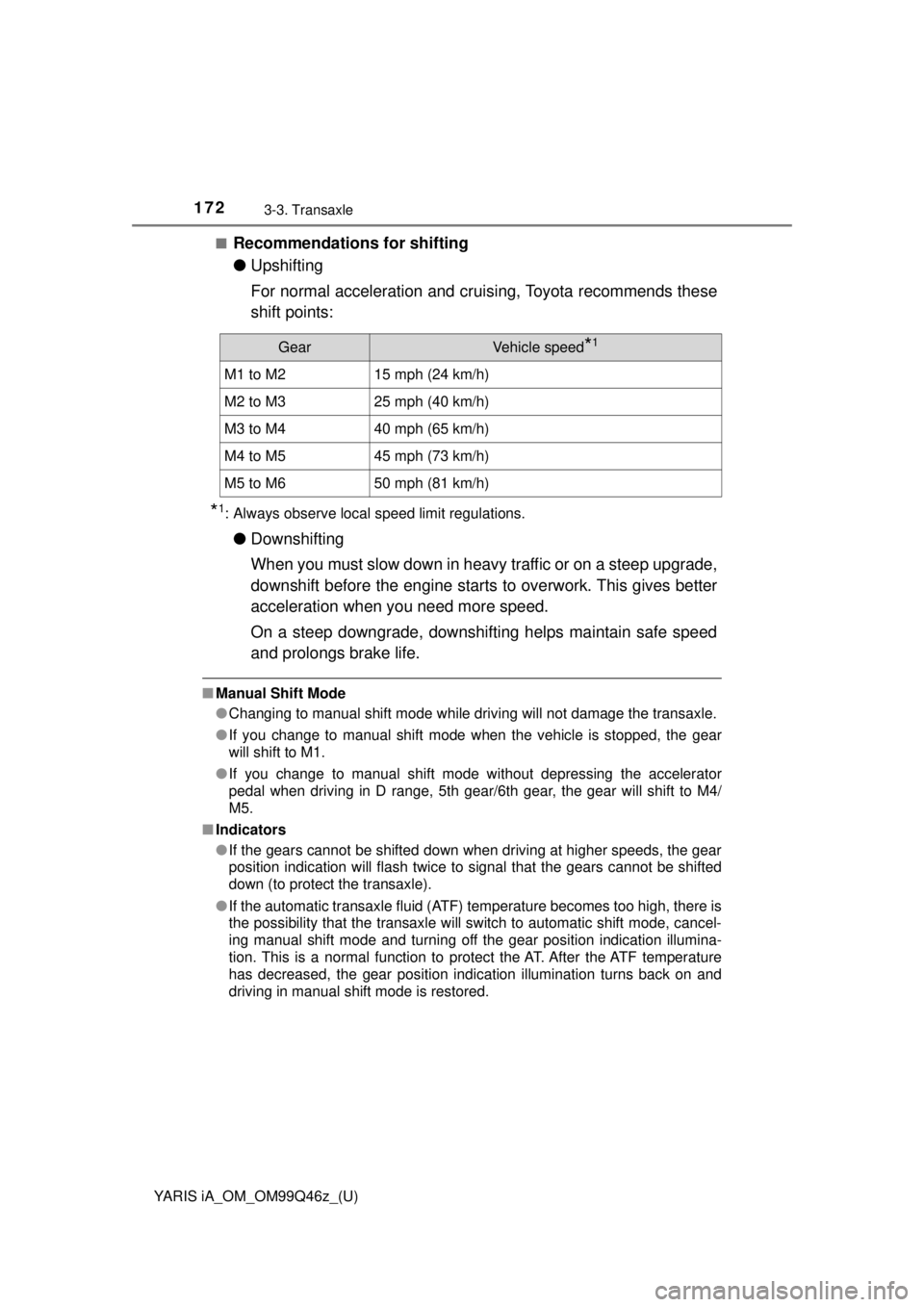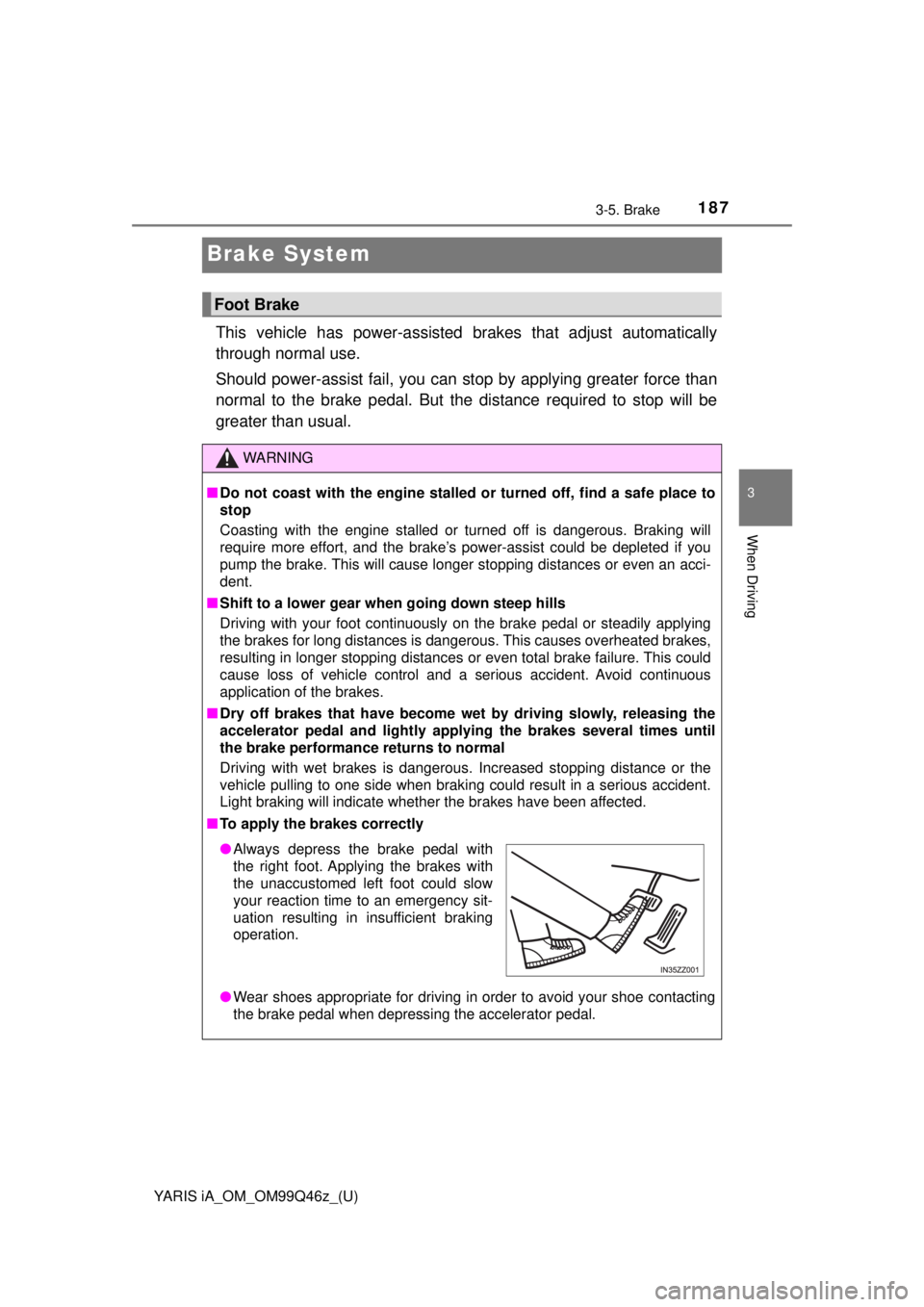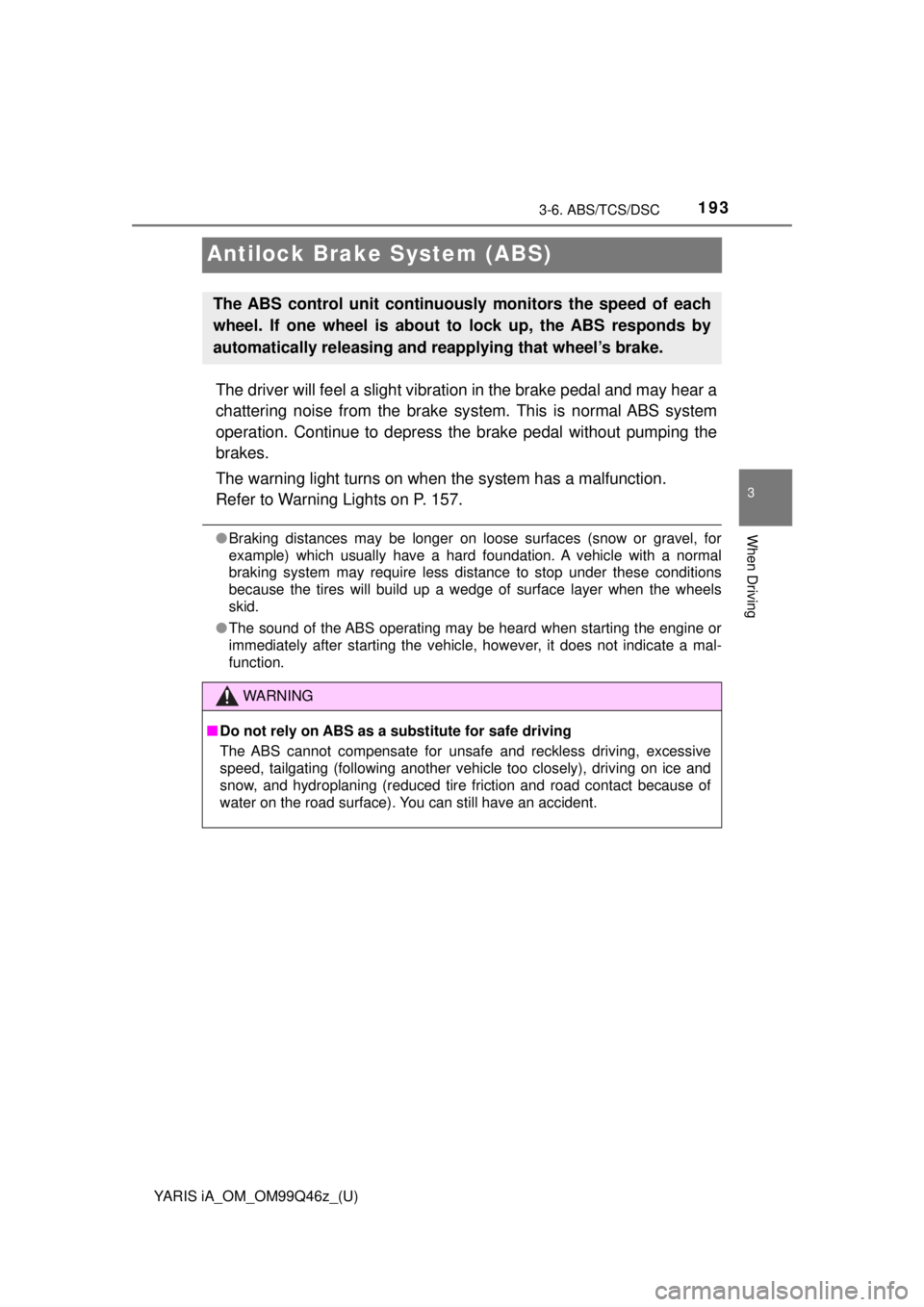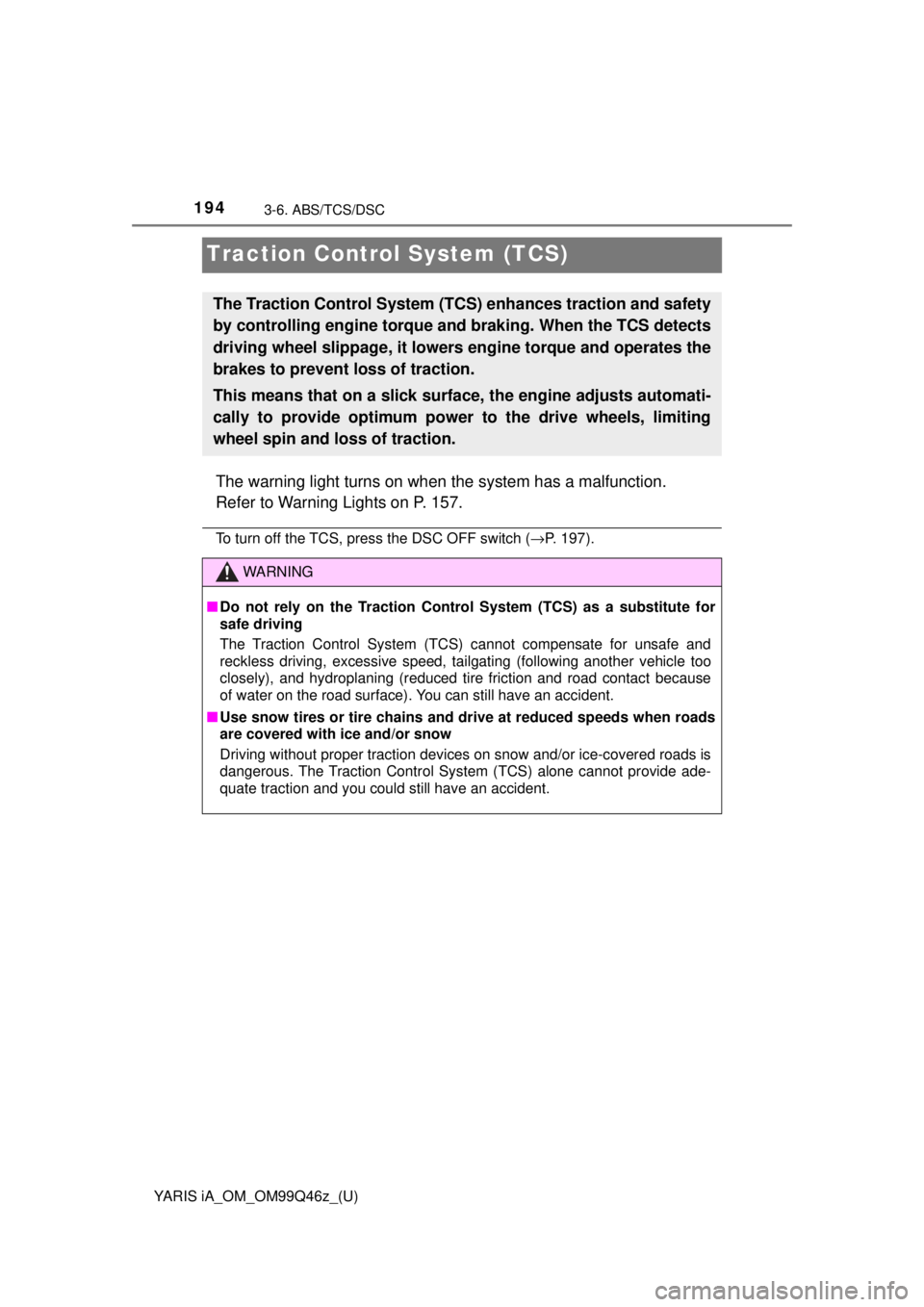Page 168 of 576
168
YARIS iA_OM_OM99Q46z_(U)
3-3. Transaxle
If the selector lever will not move from P using the proper shift proce-
dure, continue to hold down the brake pedal.
Remove the shift-lock override
cover using a cloth-wrapped flat
head screwdriver.
Insert a screwdriver and push it
down.
Press and hold the lock-release
button.
Move the selector lever.
Take the vehicle to your Toyota d ealer to have the system checked.
The manual shift mode gives you the feel of driving a manual tran-
saxle vehicle by allowing you to operate the selector lever manually.
This allows you to control engine rpm and torque to the drive wheels
much like a manual transaxle when more control is desired.
To change to manual shift mode,
shift the lever from D to M.
To return to automatic shift mode, shift the lever from M to D.
Shift-Lock Override
Cover
1
2
3
Manual Shift Mode
4
5
Page 172 of 576

172
YARIS iA_OM_OM99Q46z_(U)
3-3. Transaxle
■Recommendations for shifting
●Upshifting
For normal acceleration and cruisi ng, Toyota recommends these
shift points:
*1: Always observe local speed limit regulations.
● Downshifting
When you must slow down in heavy traffic or on a steep upgrade,
downshift before the engine starts to overwork. This gives better
acceleration when you need more speed.
On a steep downgrade, downshifting helps maintain safe speed
and prolongs brake life.
■ Manual Shift Mode
●Changing to manual shift mode while driving will not damage the transaxle.
● If you change to manual shift mode when the vehicle is stopped, the gear
will shift to M1.
● If you change to manual shift mode without depressing the accelerator
pedal when driving in D range, 5th gear/6th gear, the gear will shift to M4/
M5.
■ Indicators
●If the gears cannot be shifted down when driving at higher speeds, the gear
position indication will flash twice to signal that the gears cannot be shifted
down (to protect the transaxle).
● If the automatic transaxle fluid (ATF) temperature becomes too high, there is
the possibility that the transaxle will switch to automatic shift mode, cancel-
ing manual shift mode and turning off the gear position indication illumina-
tion. This is a normal function to protect the AT. After the ATF temperature
has decreased, the gear position indication illumination turns back on a\
nd
driving in manual shift mode is restored.
GearVehicle speed*1
M1 to M215 mph (24 km/h)
M2 to M325 mph (40 km/h)
M3 to M440 mph (65 km/h)
M4 to M545 mph (73 km/h)
M5 to M650 mph (81 km/h)
Page 173 of 576

YARIS iA_OM_OM99Q46z_(U)
1733-3. Transaxle
3
When Driving
■Manually shifting up
●When driving slowly, the gears may not shift up.
● In manual shift mode, do not run the engine with the tachometer needle in
the RED ZONE. When the engine rpm is high, a gear may shift up automat-
ically to protect the engine.
● When depressing the accelerator fully, the transaxle will shift to a lower
gear, depending on vehicle speed.
■ Manually shifting down
●When driving at high speeds, the gear may not shift down.
● During deceleration, the gear may automatically shift down depending on
vehicle speed.
● When depressing the accelerator fully, the transaxle will shift to a lower
gear, depending on vehicle speed.
WARNING
■Do not use engine braking on slippery road surfaces or at high speeds
Shifting down while driving on wet, snowy, or frozen roads, or while driving
at high speeds causes sudden engine braking, which is dangerous. The
sudden change in tire speed could cause the tires to skid. This could lead to
loss of vehicle control and an accident.
Page 174 of 576

174
YARIS iA_OM_OM99Q46z_(U)
3-3. Transaxle
■Passing
For extra power when passing another vehicle or climbing steep
grades, depress the accelerator fully. The transaxle will shift to a
lower gear, depending on vehicle speed.
Some models:
The accelerator pedal may initially feel heavy as it is being depressed,
then feel lighter as it is depressed further. This change in pedal force
aids the engine control system in determining how much the accelerator
pedal has been depressed for performing kickdown, and functions to
control whether or not kickdown should be performed.
■
Climbing steep grades from a stop
To climb a steep grade from a stopped position:
Depress the brake pedal.
Shift to D or M1, depending on the load weight and grade steep-
ness.
Release the brake pedal while gradually accelerating.
■Descending steep grades
When descending a steep grade, shift to lower gears, depending on
load weight and grade steepness. Descend slowly, using the
brakes only occasionally to pr event them from overheating.
Driving Tips
WARNING
■Do not let the vehicle move in a di rection opposite to the direction
selected by the selector lever
Do not let the vehicle move backward with the selector lever in a forward
position, or do not let the vehicle move forward with the selector lever in the
reverse position. Otherwise, the engine may stop, causing the loss of the
power brake and power steering functions , and make it difficult to control
the vehicle which could result in an accident.
1
2
3
Page 175 of 576
175
YARIS iA_OM_OM99Q46z_(U)
3-4. Switches and Controls
3
When Driving
Lighting Control
Turn the headlight switch to turn
the headlights, other exterior
lights and dashboard illumination
on or off.
When the lights are turned on, the
lights-on indicator light in the com-
bination meter turns on.
●If the light switch is left on, the lights will automatically switch off approxi-
mately 30 seconds after switching the ignition off.
The time setting can be changed.
Refer to Customizable Features on P. 562.
● To prevent discharging the battery, do not leave the lights on while the
engine is off unless safety requires them.
Headlights
Switch Position
Ignition PositionON
ACC
or
OFF
ON
ACC
or
OFF
ON
ACC
or
OFF
HeadlightsOffOffOffOffOnOn
Daytime running lights
(if equipped)OnOffOnOffOffOff
Taillights
Parking lights
License lights
Side-marker lights
Dashboard illumination
OffOffOnOnOnOn
Page 187 of 576

187
YARIS iA_OM_OM99Q46z_(U)
3-5. Brake
3
When Driving
Brake System
This vehicle has power-assisted brakes that adjust automatically
through normal use.
Should power-assist fail, you can st op by applying greater force than
normal to the brake pedal. But the distance required to stop will be
greater than usual.
Foot Brake
WARNING
■ Do not coast with the engine stalled or turned off, find a safe place to
stop
Coasting with the engine stalled or turned off is dangerous. Braking will
require more effort, and the brake’s power-assist could be depleted if you
pump the brake. This will cause longer stopping distances or even an acci-
dent.
■ Shift to a lower gear wh en going down steep hills
Driving with your foot continuously on the brake pedal or steadily applying
the brakes for long distances is dangerous. This causes overheated brakes,
resulting in longer stopping distances or even total brake failure. This could
cause loss of vehicle control and a serious accident. Avoid continuous
application of the brakes.
■ Dry off brakes that have become wet by driving slowly, releasing the
accelerator pedal and lightly applyi ng the brakes several times until
the brake performance returns to normal
Driving with wet brakes is dangerous. Increased stopping distance or the
vehicle pulling to one side when braking could result in a serious accident.
Light braking will indicate whether the brakes have been affected.
■ To apply the brakes correctly
● Wear shoes appropriate for driving in order to avoid your shoe contacting
the brake pedal when depressing the accelerator pedal.
●Always depress the brake pedal with
the right foot. Applying the brakes with
the unaccustomed left foot could slow
your reaction time to an emergency sit-
uation resulting in insufficient braking
operation.
Page 193 of 576

193
YARIS iA_OM_OM99Q46z_(U)
3-6. ABS/TCS/DSC
3
When Driving
Antilock Brake System (ABS)
The driver will feel a slight vibration in the brake pedal and may hear a
chattering noise from the brake system. This is normal ABS system
operation. Continue to depress the brake pedal without pumping the
brakes.
The warning light turns on when the system has a malfunction.
Refer to Warning Lights on P. 157.
● Braking distances may be longer on loose surfaces (snow or gravel, for
example) which usually have a hard foundation. A vehicle with a normal
braking system may require less distance to stop under these conditions
because the tires will build up a wedge of surface layer when the wheels\
skid.
● The sound of the ABS operating may be heard when starting the engine or
immediately after starting the vehicle, however, it does not indicate a mal-
function.
The ABS control unit continuously monitors the speed of each
wheel. If one wheel is about to lock up, the ABS responds by
automatically releasing and reapplying that wheel’s brake.
WARNING
■ Do not rely on ABS as a substitute for safe driving
The ABS cannot compensate for unsafe and reckless driving, excessive
speed, tailgating (following another vehicle too closely), driving on ic\
e and
snow, and hydroplaning (reduced tire friction and road contact because of
water on the road surface). You can still have an accident.
Page 194 of 576

194
YARIS iA_OM_OM99Q46z_(U)
3-6. ABS/TCS/DSC
Traction Control System (TCS)
The warning light turns on when the system has a malfunction.
Refer to Warning Lights on P. 157.
To turn off the TCS, press the DSC OFF switch ( →P. 197).
The Traction Control System (TCS) enhances traction and safety
by controlling engine torque a nd braking. When the TCS detects
driving wheel slippage, it lowers engine torque and operates the
brakes to prevent loss of traction.
This means that on a slick surface, the engine adjusts automati-
cally to provide optimum power to the drive wheels, limiting
wheel spin and loss of traction.
WARNING
■ Do not rely on the Traction Control System (TCS) as a substitute for
safe driving
The Traction Control System (TCS) cannot compensate for unsafe and
reckless driving, excessive speed, tailgating (following another vehicle too
closely), and hydroplaning (reduced tire friction and road contact because
of water on the road surface). You can still have an accident.
■ Use snow tires or tire chains and drive at reduced speeds when roads
are covered with ice and/or snow
Driving without proper traction devices on snow and/or ice-covered roads is
dangerous. The Traction Control System (TCS) alone cannot provide ade-
quate traction and you could still have an accident.